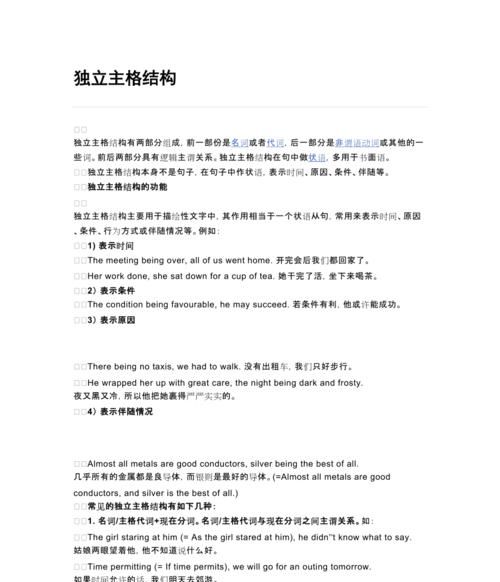本文目录
独立主格8种基本句型例句和非谓语
独立主格8种基本句型例句是:
1、名词/代词+现在分词。
2、名词/代词+过去分词。
3、名词/代词+不定式。
4、名词/代词+名词。
5.名词/代词+形容词短语。
6.名词/代词+副词。
7.名词/代词+介词短语。
8.with引导的复合结构,也可以认为是一种独立主格结构。

现在分词表示前面的名词或代词主动进行的动作或状态等。
例The man lay there, his hands trembling.
So many students being absent, the meeting had to be put off.
His homework having been done, Tom went to sleep.
注:“独立结构”中的being或having been有时可以省去,这样就成了无动词分句或过去分词分句。
独立主格例句20个
例句:
His friends to come tonight,he is busy preparing the dinner.
他的朋友今晚要来,他正忙着准备晚餐。
So many students being absent, the meeting had to be put off.
那么多学生没到,会议不得不推迟。
The job not finished, we couldn’t see the film.
工作没有完成,我们不能看电影了。
Many people joined in the work, some of them women and children.
许多人参加了这项工作,其中有些是妇女和儿童。
The floor wet and slippery, we had to stay outside for a while.
地面很湿,我们只好在外面呆一会儿。

独立主格结构在句子里的位置:
1、当独立主格结构,为前面所提到的一般叙述提供细节描写的时候,总是放在后面。
2、如果有几个独立主格结构同时出现在句子末尾,这个时候,我们通常把主要的那个独立主格结构放在句末,这样更可以增强句子的渲染力。
3、如果独立主格结构所表示的事件发生在句子的谓语动词之前,就要放在句首,这样不会产生逻辑上的混乱。
4、如果独立主格结构所表示的动作,是修饰句子中前面背动词的动作,而不是修饰后面谓语动词的动作,这种情况下,就要把独立主格结构放在句子中间。
举一些独立主格的例句和语法用法英文
独立主格结构本身不是句子,在句子中作状语,表示时间、原因、条件、伴随等。常见的独立主格结构有如下几种:
1. 名词/主格代词+现在分词。名词/主格代词与现在分词之间主谓关系。如:
The girl staring at him (= As the girl stared at him), he didn”t know what to say. 姑娘两眼望着他,他不知道说什么好。
Time permitting (= If time permits), we will go for an outing tomorrow. 如果时间允许的话,我们明天去郊游。
2. 名词/主格代词+过去分词。名词/主格代词与过去分词之间的动宾关系。如:
The problems solved (= As the problems were solved), the quality has been improved. 随着问题的解决,质量已经提高了。
Her glasses broken (= Because her glasses were broken), she couldn”t see the words on the blackboard. 由于眼镜摔坏了,她看不见黑板上的字。
3. 名词/主格代词+不定式。名词/主格代词与不定式之间是主谓关系,且强调的是一次具体性的动作。如:
He is going to make a model plane, some old parts to help. 借助于一些旧零件,他要做一个飞机模型。
They said good-bye to each other, one to go home, the other to go to the bookstore. 他们道别后,一个回了家,一个去了书店。
4. 名词/主格代词+形容词。如:
An air accident happened to the plane, nobody alive. 那架飞机遭遇了空难,无一人生还。
So many people absent, the meeting had to be called off. 这么多人缺席,会议不得不取消。
5. 名词/主格代词+副词。如:
He put on his sweater wrong side out. 他把毛衣穿反了。
The meeting over, they all went home. 会议一结束,他们就都回家了。
6. 名词/主格代词+介词短语。如:
The boy goes to the classroom, book in hand. 那男孩手里拿着书去教室。
Mary was sitting near the fire, her back towards the door. 玛丽靠近火炉坐着,背对着门。

独立主格8种基本句型例句和非谓语
独立主格8种基本句型例句是:
1、名词/代词+现在分词。
2、名词/代词+过去分词。
3、名词/代词+不定式。
4、名词/代词+名词。
5、名词/代词+形容词短语。
6、名词/代词+副词。
7、名词/代词+介词短语。
8、with引导的复合结构,也可以认为是一种独立主格结构。

独立主格结构注意事项
1、独立主格结构多用于书面语,尤其是描述性语言中,在口语和非正式文体中,一般用从句或 两个句子来代替。独立主格结构的逻辑主语与句子的主语不同,它独立存在,名词或代词与后面的分词等逻辑上是主谓关系,独立主格结构一般有逗号与主句分开。
The president assassinated, the whole country was in deep sorrow.
总统被谋杀了,举国上下沉浸在悲哀之中。
2、动词不定式表示动作没有发生或即将发生,动词-ed形式表示动作已经结束,动词-ing形式往往表示动作正在进行。
The manager looks worried,many things to settle.
经理看上去很着急, 有这么多的事情要处理。
以上就是关于独立主格万能例句 ,独立主格8种基本句型例句和非谓语的全部内容,以及独立主格万能例句 的相关内容,希望能够帮到您。
